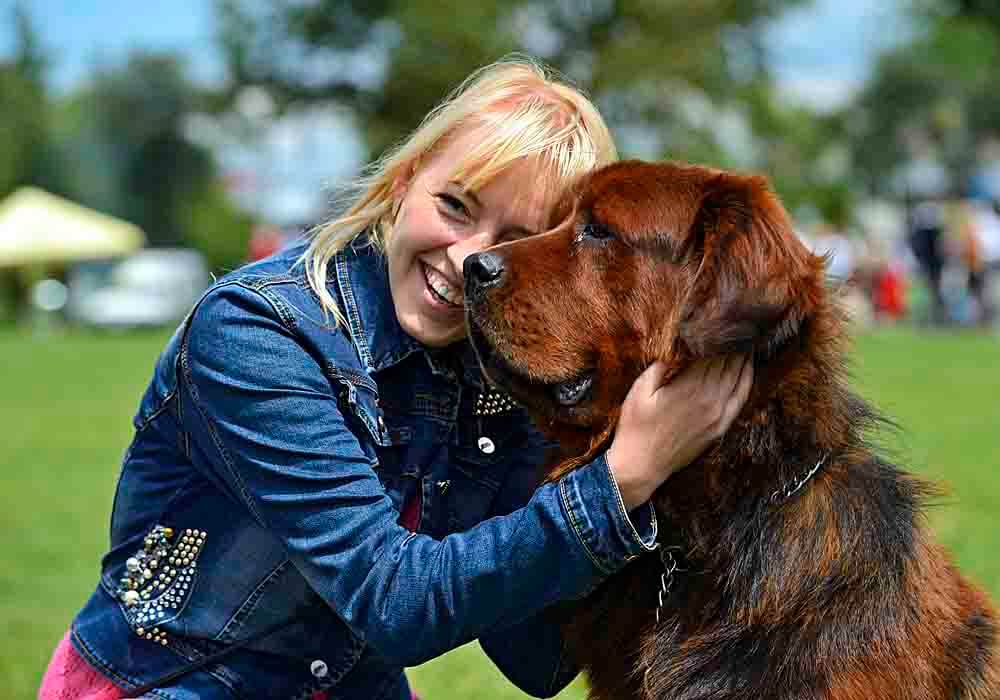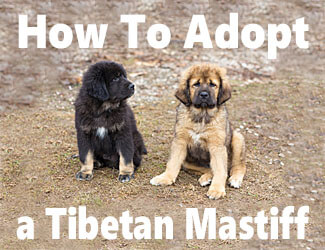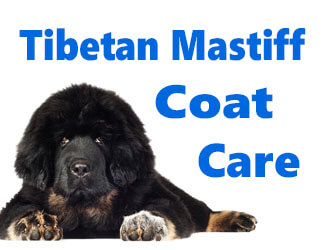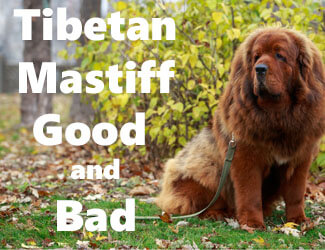What To Know About
Tibetan Mastiffs
Top 22 Questions Answered
by Ken Alden
Tibetan Mastiffs are unforgettable. Who wouldn’t want a dog that looks like a lion and weighs more than a female black bear? They are expensive, but that’s just part of the allure.
Tibetan Mastiffs are beautiful dogs with an ancient history, but they are also highly territorial pack protectors that can be dangerous if not properly trained and maintained. Tibetan Mastiffs should only be kept by experienced dog owners who have worked with large dominant breeds.
Want to learn more? Below you have 22 Tibetan Mastiff questions, and I have 22 Tibetan Mastiff answers.
Pro-tip: Ever try lifting a Tibetan Mastiff? Their weight can hurt not only your back but their joints when they hop down from cars, sofas or even your bed. To protect your back and theirs check out the best Mastiff ramps on Amazon.com now.

Are Tibetan Mastiffs Affectionate?
If you are looking for a face-licking tail-wagging love sponge, you might be disappointed by a Tibetan Mastiff. They are fiercely loyal to their families and enjoy praise and occasional petting, but Tibetan Mastiffs are reserved in their displays of affection. what to know about tibetan mastiffs
Tibetan Mastiffs behave more like cats than dogs, as they want cuddles on their terms. Tibetan Mastiffs enjoy playtime and kind words from their owners, but they will quietly stroll away when they feel the need for their own space.
Are Tibetan Mastiffs Dangerous?
At an adult weight of up to 150 lbs (68 kg), Tibetan Mastiffs are formidable guard dogs. They can do serious damage to anything they perceive as a threat, and because Tibetan Mastiffs were bred as herding and guard dogs, they can be quick to perceive threats.
Before getting a Tibetan Mastiff, make sure you can handle a large, strong dog. Obedience classes from an early age will help keep your big protector under control if she mistakes your mail carrier for a wolf who has come to steal sheep.
Also, check your town’s local ordinances against large and potentially dangerous dogs. In China, several large cities have regulated or outright banned Tibetan Mastiffs.
Because they are uncommon outside China, there are few breed-specific Tibetan Mastiff bans on the books. But many cities and towns forbid dogs over a certain size, and most local officials will look dimly at a large dog involved in an incident.
Are Tibetan Mastiffs Easy To Train?
The good news is that Tibetan Mastiffs are very intelligent dogs, but the bad news is that they are very stubborn. Since they are capable of learning obedience, and, given their size and protective tendencies, they should receive obedience training.
However, they might not always cooperate.
Because they were so often used for herding, Tibetan Mastiffs think for themselves. Training herding dogs is a special skill., and an obedience trainer who works with Collies might do better than a trainer with guard dog experience.
Are Tibetan Mastiffs Friendly?

Tibetan Mastiffs are naturally suspicious of strangers. A properly socialized Tibetan Mastiff will be fine with guests but will take a while to warm up to them.
Even when they finally decide they like you, Tibetan Mastiffs will not make a great show of it. what to know about tibetan mastiffs
If your friends are dog-lovers, they may be upset with your fluffy teddy bear’s chilly response. But if your friends prefer other animals like cats, they may be fine with a dog who watches them quietly from a respectful distance.
Pro-tip: Tibetan Mastiff anxiety, aggression, destructive chewing, jumping up, fearfulness, and other behaviors can be controlled with the right training program.
Here’s a great course that addresses these issues along with many other dog training basics: Check it out now!
Are Tibetan Mastiffs Good Family Dogs?
Tibetan Mastiffs can be excellent family pets for somebody with experience living with large guard dogs. The Tibetan Mastiff is independent-minded and can be protective to a fault, but if you have never worked with a big and potentially aggressive dog, a Tibetan Mastiff might be overwhelming.
Your Mastiff will need a fenced yard to play in, regular socialization to keep them accustomed to strangers, and a firm but patient owner who can set boundaries.
If you can provide that, you will find your Tibetan Mastiff a loyal companion and protector.

We felt this topic deserved great coverage, so we wrote this dedicated article Are Tibetan Mastiffs Good Pets which covers everything.
Are Tibetan Mastiffs Good With Other Dogs?
Tibetan Mastiffs will often assert dominance when they encounter strange dogs. If the other dog rises to the challenge, things can quickly get ugly, so you should never walk your Tibetan Mastiff without a leash.
When Tibetan Mastiffs are raised with other animals, they see them as part of the pack. Not only will they get along with your household dogs, but they will also rush to their defense. what to know about tibetan mastiffs
A properly socialized Tibetan Mastiff will behave well around other dogs when outside his territory, but that socialization must start at an early age. Tibetan Mastiff puppies need regular exposure to walks around strangers.
Without that socialization, their protective instincts will take over, and your Tibetan Mastiff may become dog and stranger aggressive.
Are Tibetan Mastiffs Rare?
Pure Tibetan Mastiffs are hard to find in their Himalayan homeland, but they are even harder to find outside Tibet. While dogs with Tibetan Mastiff heritage are common in their homeland, those with pure Tibetan Mastiff ancestry are rare and command a premium price. what to know about tibetan mastiffs
Tibetan Mastiffs are a primitive breed with roots stretching back over 50,000 years. Geneticists believe the Tibetan Mastiff is the ancestor of Europe’s mastiff breeds.
Even in the Bronze Age, imported Tibetan Mastiffs were in high demand. Then, as well as now, many Tibetan Mastiff buyers find themselves unable to cope with their new pet’s needs. After a 2018 downturn in China’s Tibetan Mastiff market, many breeders abandoned their dogs.
Tibetan Mastiffs are a rare treasure that deserves the best possible home, with an owner who is ready to share the privilege of living with one of the world’s most ancient dog breeds.
Can Tibetan Mastiffs Swim?
While some Tibetan Mastiffs enjoy swimming, the Tibetan Mastiff is not a water dog by nature. Your Tibetan Mastiff may or may not like water, because their heavy coat is better suited for winter herding than summer swimming.
If you want a giant water-loving dog, you will probably do better with a Newfoundland breed, as these gentle giants were bred to rescue sailors thrown overboard. They are big as a Tibetan Mastiff and more easy-going, and will happily swim at every opportunity.
Do Tibetan Mastiffs Bite?
Tibetan Mastiffs bite to protect their family, herd, and property, and when they bite, they bite hard. A Tibetan Mastiff can bite with over 500 psi (225 kg), which is more than twice the pressure that German Shepherds and Pit Bulls can apply.
In January 2020, a 200 pound (89 kg) Tibetan Mastiff in Edinburgh, Scotland, was put down after attacking a 17-year-old schoolgirl, a 73-year-old pensioner, and a 53-year-old mother.
Your Tibetan Mastiff needs to know the difference between a visitor and a genuine threat, as a Tibetan Mastiff attack is serious and could easily become fatal.
Pro-tip: Tibetan Mastiff's (and their owners) love dog crates…and for good reasons. Crates keep dogs from mischief while you're away, are perfect for house training, for traveling by car, and provide the dog a place to de-stress. Check out the best Mastiff crates on Amazon.com now.
Do Tibetan Mastiffs Bark a Lot?
Tibetan Mastiffs are not generally noisy dogs. But when they bark, they bark loudly, and like any guard dog, Tibetan Mastiffs will sound an alarm when they sense possible danger.
Because they were bred for watching herds, Tibetan Mastiffs can be especially vigilant at night. Many Tibetan Mastiff owners bring their dogs indoors after dark, so they do not keep the neighborhood awake, warning of every passing raccoon, squirrel, or cat.
Do Tibetan Mastiffs Drool?
Tibetan Mastiffs have the loose jowls common to most Mastiff breeds, which means they slobber. Drool is an inevitable part of keeping most giant dog breeds, and Tibetan Mastiffs are certainly giants.
Your Tibetan Mastiff could be drooling because of anxiety. Even giant dogs get stressed with their lives sometimes, so give your big bundle of nerves more walking time and a quiet environment. what to know about tibetan mastiffs
A peaceful home benefits you and your dog.
Tibetan Mastiffs may not always show it, but they love their families and can sense any tension in your home. If your Tibetan Mastiff is drooling a lot recently, he may be worried by personal conflicts.
Do Tibetan Mastiffs Need a Lot of Exercise?
Tibetan Mastiffs don’t require a lot of exercise, so a backyard (preferably one with a 6’ or 1.83 meters or higher fence) and a 30-minute walk every day should keep your Tibetan Mastiff in reasonably good shape.
When you walk your Tibetan Mastiff, you may want to vary the route, because if you always follow the same path, your Tibetan Mastiff may begin to see your walking path as his territory.
Though it should go without saying, never walk your Tibetan Mastiff without a leash. Your dog may come when you call a hundred times, but Tibetan Mastiffs are notorious for ignoring commands when you most need them to listen.
Given a choice between obeying your order and chasing that interesting cat, your Tibetan Mastiff will more often than not declare mutiny. And if your dog injures an animal or person, you could face heavy civil or even criminal penalties.

Even though this breed doesn't need a lot of exercise, what they do require can be rather specialized. For a much greater coverage of this topic check out our article Tibetan Mastiff Exercise Needs.
Do Tibetan Mastiffs Shed a Lot?
As a rule, Tibetan Mastiffs do not shed like other dogs. They hold onto that long coat, beneath which lies a wooly undercoat that keeps them warm through cold Tibetan nights. But once every year, Tibetan Mastiffs “blow” their coat. While other dogs shed throughout the year with a heavier period in spring, Tibetan Mastiffs save everything for one big hair drop.
During this period, your Tibetan Mastiff will need regular brushing. You can also expect a lot of extra vacuuming and sweeping.
Do Tibetan Mastiffs Smell?
Tibetan Mastiffs do not have the “doggy” smell which some dog owners love, and everyone else tolerates. Their long coats and wooly undercoats mean that Tibetan Mastiffs are not hypoallergenic, but they are as odor-free as dogs get.
If your Tibetan Mastiff rolls around in something smelly, it will bring that stench home in its coat.
Normally Tibetan Mastiffs are fine with a bath every two to six weeks, but you can step up the schedule if your Tibetan Mastiff encounters rotting garbage or a neighborhood skunk.
How Large Do Tibetan Mastiffs Get?
Tibetan Mastiffs look bigger than they are thanks to their long coat and fluffy lion’s mane. But even without their hair Tibetan Mastiffs are nothing to sneeze at. A Tibetan Mastiff is only slightly smaller than a Saint Bernard or an Old English Mastiff in weight and height.
If you want a Tibetan Mastiff, you will need a large space for it to sleep and play.
How Long Do Tibetan Mastiffs Live?
According to the American Kennel Club, Tibetan Mastiffs have a life expectancy of between 10-12 years, while PetMD says the Tibetan Mastiff’s average life expectancy is 11-14 years.
This lifespan may not seem very long next to the Guinness World Record holder Bluey, an Australian Cattle Dog who lived 29 years and five months. But it’s great next to the average lifespan for other mastiffs like the Dogue de Bordeaux (5-8 years).
How Much Do Tibetan Mastiff Puppies Cost?
In March 2014, a Chinese real estate developer paid $1.9m for a 31 inch tall (79cm) Tibetan Mastiff, which weighed 200 pounds (90.7kg) that reputedly had “lion’s blood.”
While he was hoping to breed his new pet, we have no further information on what the Chinese developer charges for the puppies. In the United States, a Tibetan Mastiff puppy will cost between $2,500 and $5,000, while reputable breeders may charge well over $10,000.
Buying a Tibetan Mastiff is a big investment, but the money you spend on buying a healthy and well-bred puppy now could save you a lot of trouble and heartbreak later.
Because Tibetan Mastiffs are so uncommon, quite a few lines have become inbred.
How Much Do Tibetan Mastiffs Eat?
Tibetan Mastiffs eat less than you might expect, given their size. An adult Tibetan Mastiff may only eat two to four cups of food daily.
Given sufficient exercise, your Tibetan Mastiff will generally refrain from overeating, as they are not ravenous eaters and will even skip meals on occasion.
If your Tibetan Mastiff is refusing food, try moistening dry food with beef or chicken broth or mix in wet dog food with the dry, and check your dog’s mouth for tooth problems that might make eating painful. But if there is a female dog in heat nearby, males may go off their feed for over a week.
Be careful about exercising your dog sooner than 30 minutes after a meal. Like many giant dog breeds, Tibetan Mastiffs may get bloat (gastric torsion) if they exert themselves immediately after eating.
Young Tibetan Mastiffs sometimes have food issues. They may guard their food bowl zealously and rush over when someone comes near it, refuse food altogether, or even become food aggressive when somebody picks up their empty dish.
Tibetan Mastiff youngsters are learning their place in the pack, and determining who eats where and when is a big part of pack behavior. If you don’t work with your Tibetan Mastiff’s food issues now, you might wind up dealing with food aggression or anorexia later. what to know about tibetan mastiffs
How Much Do Tibetan Mastiffs Shed?
Most of the time, not much, but when spring rolls around, Tibetan Mastiffs lose most of their coat. That long beautiful hair that looks so amazing on your Tibetan Mastiff is a lot less attractive on your furniture, clothes, and floor.
Tibetan Mastiffs should be brushed weekly to get rid of knots and debris in their coat. When Tibetan Mastiffs are blowing their winter coat, they should be brushed daily.
Daily brushing allows you to get rid of the hair in one spot and saves you a lot of sweeping.
How Much Do Tibetan Mastiffs Weigh?
The AKC Breed Standard states that a male Tibetan Mastiff should weigh between 90 to 150 pounds (41 to 68 kg) and a female between 70 to 120 pounds (32 to 54.5 kg). There are many heavier Tibetan Mastiffs out there, but not all of those dogs are healthy.
Tibetan Mastiffs are prone to becoming overweight, and like humans, obesity in dogs can lead to joint issues, back pain, inflammation, and heart disease.
While Tibetan Mastiffs are less likely to overeat than other mastiffs, they can still gain weight if not exercised. You’ll need to encourage your Mastiff because they can be lazy, especially as they get older. what to know about tibetan mastiffs What to know about Tibetan Mastiffs
Keep your Tibetan Mastiff on a sensible diet and make sure he gets plenty of exercise. Working together, you two can help keep each other in shape.
Why Are Tibetan Mastiffs So Rare?
Part of the problem is distance. The Tibetan Mastiff’s Himalayan homeland is remote, and much remains inaccessible, so getting dogs from Tibet to the rest of the world is no small task.
There are breeders outside China working with Tibetan Mastiff lines. But because of the Tibetan Mastiff’s size, and often, its temperament, only a few are up to the challenge of keeping and breeding these lion dogs.
Is a Tibetan Mastiff a Good Family Dog?
Tibetan Mastiffs are fiercely loyal and devoted to their family, but the problem comes with that pesky word, “fiercely.” Tibetan Mastiffs see their family as a pack and believe it is their job to defend the pack.
When your big fluffy boy defends your house from burglars, this is a good thing, but when he bares his teeth at the door and refuses to let your next-door neighbor enter, not so much. Of course, if your neighbors are not very friendly, that might not be such a bad thing.
Tibetan Mastiffs respond poorly to conflict. If they see your children rough-housing, they may think a fight is in progress and try to break it up, and if they don’t know the other child well, your Tibetan Mastiff may break the “fight” up roughly.
To your Tibetan Mastiff, home is pack territory. Intruders are generally up to no good, so the Tibetan Mastiff is inclined to drive them off.
You can curb that instinct to some extent by early socialization. But many Tibetan Mastiffs need to be locked away in a crate or kennel when company comes because they will not tolerate strangers on their territory.

So just how is this breed around children? Are they loving and trustful?...or should parents beware? This will answer just this question just this question... How Are Tibetan Mastiffs With Kids And Babies?
What To Know About Tibetan Mastiffs...Final Thoughts
Big dogs are a big responsibility. If you can handle that responsibility, you may find these giants to be loving protectors. Now that you know more about Tibetan Mastiffs, you can decide if a Tibetan Mastiff is the right dog for you.
Return to the top of this What To Know About Tibetan Mastiffs page

About the Author...
Ken Alden, a dedicated Mastiff owner for over eight years, is acclaimed for his expertise in care, grooming, and training. Read more About Me and my dog Shadow.
- Mastiff Guide Home ›
- Tibetan Mastiffs Info ›
- What To Know About Tibetan Mastiffs






